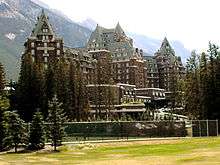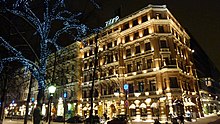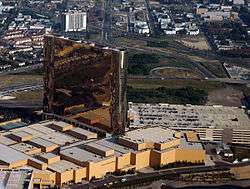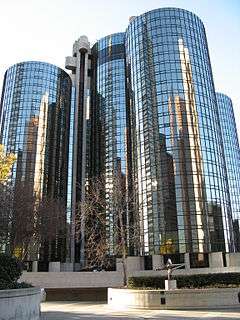Resort hotel
A resort hotel is a hotel which often contains full-sized luxury facilities with full-service accommodations and amenities. These hotels may attract both business conferences and vacationing tourists and offer more than a convenient place to stay.[1] These hotels may be referred to as major conference center hotels, flagship hotels, destination hotels, and destination resorts. The market for conference and resort hotels is a subject for market analysis.[2]
These hotels as destinations may be characterized by distinctive architecture, upscale lodgings, ballrooms, large conference facilities, restaurants, and recreation activities such as golf or skiing. They may be located in a variety of settings from major cities to remote locations.
History
Since the 1800s, the traditional concept full-service conference and resort hotels have been based upon a venue which is typically remote and has a natural feature as its attraction.[2] For example, the Kviknes Hotel in Norway is a difficult to reach remote location which provides visitors access to the scenic fjord at Balestrand or The Brando Resort on Tetiaroa which is only accessible by a private plane from Tahiti. Historically there were certain built-in amenities such as gourmet cuisine, music recitals, and shoreline trails; however, the amenities of modern (post-1980) destination hotels dwarf the scale of these earlier models. Many of the Las Vegas and Caribbean resort hotels have complete shopping malls, conference centers and large entertainment halls on site; thus, the contemporary version of a destination often features large on-site capital investment in activities, although the access to a local natural feature is still retained by many newer destination hotels.
A mega-resort is a type of destination which is of an exceptionally large size, sometimes featuring large-scale attractions (casino, golf course, theme park, multiple accommodations). The hotels along the Las Vegas Strip are most typically thought of as mega-resorts owing to their immense size and complexity. Kirk Kerkorian is credited for building the first mega-resort in 1969 earning him the nickname "father of the mega-resort".
Two projects in Las Vegas in 1969 and 1973[3][4][5] [6] by architect Martin Stern, Jr. and entrepreneur Kirk Kerkorian, the International Hotel and the MGM Grand, set the standard for such casino resorts. The Mirage gave its size and emphasis on non-gaming entertainment options like shopping and fine dining to draw in customers. Mega-resorts use the same fantastic or mythical theme (medieval life at Excalibur, tropical at The Mirage, famous cities, etc.) throughout their properties.
Many mega-resorts have a large theme park as its centerpiece. Resorts such as the Walt Disney Parks and Resorts feature multiple hotels, multiple theme parks, a shopping complex, and other features. Other mega-resorts exist with no specific centerpiece, having many features that are considered prominent, such as Atlantis Paradise Island and its upcoming sister park in Dubai.
Gallery
 The Las Vegas Strip has dozens of luxury resorts
The Las Vegas Strip has dozens of luxury resorts

_03.jpg) The Westin Palace Madrid
The Westin Palace Madrid

 The Borgata in Atlantic City
The Borgata in Atlantic City- Sun City in North West Province, South Africa

References
- Alvin L. Arnold, Arnold Encyclopedia of Real Estate, John Wiley and Sons (1995).
- Grant Ian Thrall, Business Geography and New Real Estate Market Analysis, Oxford University Press, Oxford, England (2002).
- "The Hidden History of the Xanadu". University of Nevada, Las Vegas Center for Gaming Research.
Two Martin Stern-designed and Kirk Kerkorian-built casinos, the International (later Las Vegas Hilton) and MGM Grand (later Bally's) had just raised the bar in casino/hotel design. Whereas previous casinos had featured modest, low-slung motel wings or mid-rise hotel extensions, these two structures opened with over 2000 rooms and suites located in mammoth hotel towers. These two projects boasted virtually every feature of what is today canonical casino resort construction: a single complex combining casino, dining, and entertainment facilities with a massive hotel.
- "Remembering Martin Stern, Jr.: Architect of the Modern Casino Resort". University of Nevada, Las Vegas Center for Gaming Research.
Stern’s most enduring contribution to the Strip was his trailblazing fusion of convention hotel, casino space, and retail, seen first in 1969 in Kirk Kerkorian’s International and then in his original MGM Grand, which opened in 1973. These behemoths integrated high-rise hotel towers, parking garages, convention space, gaming, entertainment, and shopping for the first time. These structurally integrated designs supplanted the patchwork of older Strip casinos, which had grown by adding a showroom here or a hotel tower there. And the International pioneered the tri-form, y-shaped design that has become a Strip trademark. The freshly minted mega-resorts of the 1990s, from The Mirage to Paris, all used Stern’s basic ideas of casino design.
- "Nevada Swings Into the Seventies". Southwest Contractor. Archived from the original on 2011-09-29.
The massive, 2.5 million sq.-ft. MGM Grand set a new standard in defining the mega-resort. The monolithic building, larger than in size than the Empire State Building, had over 300 miles of draperies, 2,300 television sets, and enough heating and cooling capacity to serve 8,000 homes.
- "Resort Hotel Android".